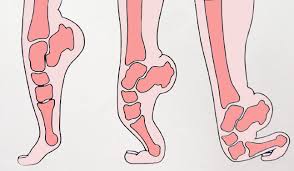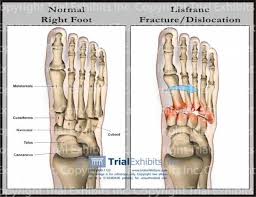With the Fall Season, the American public consumes Football more than any other sport. It is also among the most violent contact sports. Both contact and non-contact injuries are extremely prevalent. Furnace Brook PT will discuss 2 serious foot injuries over this post and the next, that are very common in football; Lisfranc and Jones fractures. We will touch upon how they are sustained, which types of players typically sustain them, and what the post-injury process involves from a rehabilitation perspective.
Lisfranc Fractures:
Also referred to as a Lisfranc Injury, a Lisfranc fracture involves a dislocation of the 1st and/or 2nd metatarsal joints proximally as they articulate with the tarsus (midfoot). This causes significant trauma to the surrounding ligamentous structures, either fully or partially tearing them, and can also result in bony and cartilaginous injuries if the force involved is high enough. For football players, this injury typically occurs when pivoting or twisting on a plantar-flexed (toes pointing downwards) OR when an additional compressive or downward directed force is added to a planted, plantar-flexed foot. Usually, it is seen most often in linemen on either side of the ball. Generally, it will occur when linemen have the misfortune of somebody landing on their heel or lower leg while they are planted and trying to drive off of their toes to push their opposition. Just this week, Washington Redskins 1st round rookie draft pick Jonathan Allen suffered a Lisfranc Injury which will keep him off the field for some time.
Immediately following, this injury will present with swelling, tenderness, bruising, and severe pain with weight-bearing. Bruising on the sole of the foot with severe tenderness to the arch and pain with midfoot stress testing are a good indicator that the player has sustained this type of injury. Imaging is required to definitively confirm the diagnosis. An X-Ray is generally sufficient for initial diagnosis, but surgeons may order an MRI or CAT scan to determine the full scope of the damage and better prepare for surgery.
These types of injuries generally require surgical intervention to stabilize the midfoot region, although it can be managed conservatively in mild cases. Surgeons employ a variety of surgical fixation techniques to stabilize the area, and the type of procedure will change depending on severity of the injury and skill level / preference of the surgeon.
From a rehabilitation perspective, patients who suffer this injury are typically placed in crutches and kept in a non-weightbearing or touch-down weightbearing status for 6-8 weeks based on the surgeon’s discretion. During this time, the focus of skilled physical therapy is on symptom management and restoration of normal foot / ankle range of motion and mobility as tolerated. Early utilization of water(pool) therapy can be extremely advantageous for conditioning and muscle activation when the weight bearing status is limited. Also, when loading is reduced or prohibited in exercise, Blood Flow Restriction (BFR) training can also be employed as a means of strengthening the surrounding musculature that has atrophied. After 6-8 weeks, the patient’s weight-bearing status is usually progressed to WBAT (weight-bearing as tolerated), and they are gradually weaned from crutches and other assistive devices over the following 2-3 weeks. During this time, basic ankle and foot strengthening is initiated, such as progressive resisted exercises with thera-band for the ankle, or marble pick-ups or “doming” for the intrinsic foot muscles. As the patient continues to progress, functional strengthening and balance related exercises are initiated around the 10-12 week mark, and then return to sport activity is initiated around week 20; always pending the surgeon’s clearance.
Furnace Brook Physical Therapy is well versed in treating Lisfranc fractures and also offers onsite Pool Therapy and Blood Flow Restriction training to optimize the patient’s outcome. Be sure to check back next week for a post on Jones Fractures involving the 5th metatarsal, which are far more common in football “skill” players. 

